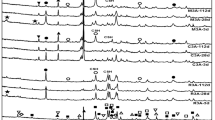Abstract
The Young's modulus and flexural strength were determined for glass polyalkenoate cements as a function of poly(acrylic acid), PAA molar mass, concentration, glass volume fraction and cement ageing time. The Young's modulus was independent of PAA molar mass. The Young's modulus increased dramatically with the PAA concentration of the cement until concentrations greater than 50% m/m were reached. The modulus increased with time for nearly all the cements investigated consistent with a continuing ionic cross-linking process in the cement matrix. The modulus increased with an increase in the volume fraction of the higher modulus glass phase. Increasing the glass volume fraction provides more surface area for acid attack resulting in a more cross-linked polysalt matrix, as well as increasing the volume fraction of residual glass particles. Flexural strength was highly dependent on molar mass of the PAA and its concentration. The molar mass dependence of the flexural strength was greatest at higher PAA concentrations.
Similar content being viewed by others
References
C. Lin and W. H. Douglas, in “Glass Ionomers the Next Generation,” edited by P. Hunt, International Symposia in Dentistry, June 1994, Philadelphia.
M. A. Cattani-Lorrente, C. G. Godin and J. Meyer, Dent. Mater. 10 (1994) 37.
R. Guggenberger, R. May and K. P. Stefan, Biomaterials 19 (1998) 479.
G. Pearson and A. Atkinson, ibid. 12 (1991) 169.
A. D. Wilson, C. P. Warrens and R. G. Hill, J. Mater. Sci.24 (1989) 363.
K. Kendall, Proc. R. Soc. Lond. A. 361 (1978) 245.
B. W. Darvel, J. Mater. Sci. 25 (1990) 757.
B. Fennel and R. G. Hill Part I. ibid. this issue.
Idem., Dental Materials 14 (1998) 358.
ISO 7489, Dental Glass Polyalkenoate Cements, 1986.
R. G. Hill, J. Mater. Sci. 28 (1993) 3851.
S. Crisp, B. G. Lewis and A. D. Wilson, J. Dent 4 (1976) 162.
ASTMS D790-1, Standard Methods of Test for the Flexural Properties of Plastics American Society of Testing and Materials, Philadelphia, 1971.
S. Griffin and R. Hill, J. Mater. Sci. 33 (1998) 5383.
E. De Barra, Ph.D. thesis, University of Limerick, 1997.
E. De Barra and R. Hill, J. Mater. Sci. 33 (1998) 5487.
H. J. Prosser, D. R. Powis and A. D. Wilson, J. Dent. Res. 65 (1986) 146.
S. Crisp, B. G. Lewis and A. D. Wilson, J. Dent. 5 (1977) 51.
M. A. Azillah, H. M. Anstice and G. J. Pearson, ibid. 26 (1998) 177.
V. H. W. Khouw-Liu, H. M. Anstice and G. J. Pearson, ibid. 27 (1999) 351.
J. A. Williams and R. W. Billington, J. Oral Rehab. 18 (1991) 163.
Author information
Authors and Affiliations
Corresponding author
Rights and permissions
About this article
Cite this article
Fennell, B., Hill, R.G. The influence of poly(acrylic acid) molar mass and concentration on the properties of polyalkenoate cements Part II Young's modulus and flexural strength. Journal of Materials Science 36, 5177–5183 (2001). https://doi.org/10.1023/A:1012441727897
Issue Date:
DOI: https://doi.org/10.1023/A:1012441727897




